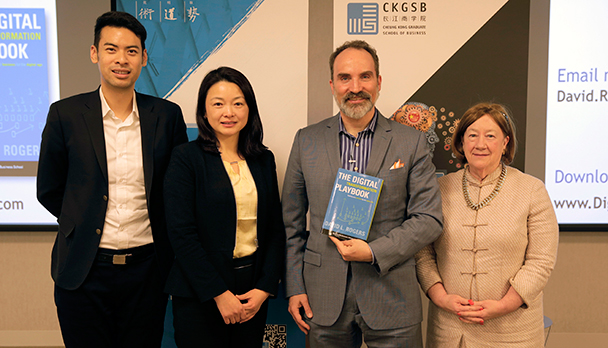Traditional businesses seeking a digital-age makeover should first concentrate on changing their strategic thinking, not their technology, a Columbia University digital business strategy expert told a CKGSB Knowledge Series audience.
David Rogers, a member of the executive education faculty at Columbia Business School and author of the newly released book, “The Digital Transformation Playbook: Rethink Your Business for the Digital Age” (Columbia University Press), said that a lot of pre-Internet era companies stumble by thinking technology is what they need to change most in a digital transition.
“The bigger and more important challenge is actually changing the strategic thinking that is driving the organization,” Professor Rogers said during his talk at CKGSB Americas’ New York office. The May 5 event, part of a regular series of talks and lectures pertaining to building and expanding a China business, was moderated by Sun Baohong, the Dean’s Distinguished Chair Professor of Marketing, Associate Dean of Global Programs and Director of the Customer Information Management Center at CKGSB.

CKGSB Professor of Marketing Sun Baohong (second from left) moderated the discussion with Columbia Business School Professor David Rogers (second from right)
“For businesses that arose before the digital era, before the Internet, their way of thinking about the customer, markets, competition, data and value has been shaped by a very different environment,” Professor Rogers said. “And they have to unlearn a lot of their assumptions before they can take advantage of the opportunities of the digital era.”
Five strategy domains
In his talk, Professor Rogers discussed five domains of strategy that companies need to rethink when reimagining themselves for the digital era: customers, competition, data, innovation and value.
A key to success in digital is understanding that customers have evolved from passive targets to empowered dynamic forces who have the ability both to manage product information and choices and to communicate with fellow shoppers through social media tools such as WeChat. Businesses also have to understand consumers’ differing on-line and in-store shopping behavior. Price checking – where the shopper uses his mobile device to quickly survey prices for an item at a range of competing outlets – is a competitive threat; but behaviors such as checking product reviews and soliciting feedback from other customers via social media can help consumers proceed with an in-store purchase.
Business leaders need to realize that the digital revolution has redefined competition. “Traditionally, competition was a zero-sum game,” Professor Rogers said. “Competition today has changed. We are seeing the rise of frenemies, where the same company that is your biggest competitor also is your biggest business partner. Companies also are competing not just with firms with the same business model as you, but with companies that don’t look like you at all – but solve the same problem as you do for your customer.”
Until recently, China’s Internet economy was consumer driven. Today, China’s companies are quickly climbing the adoption curve. A McKinsey Global Institute report last year showed that Chinese companies are investing heavily in the building blocks of the Internet economy: cloud computing, wireless communications, new digital platforms, big data analytics, and more. Across six sectors, which accounted for 25 percent of Chinese economic activity in 2013, McKinsey found that increased Internet adoption could add 60 billion to 1.2 trillion RMB (about $10 billion to $190 billion) in GDP to individual sectors by 2025.
Asian businesses have tended to be faster adopters of digital thinking than the West, partly because they largely skipped landline technology and the desktop Internet era, moving straight to mobile amid a rapid rise in regional cell phone ownership.
“I’m working with lot of companies in the West that were started more than 100 years ago, maybe more than 200 years ago,” Professor Rogers said. “That’s a lot of institutional history. You have to take advantage of the strengths but also unlearn some of the old ways of thinking. Whereas in a fast developing market like China, even the pre-digital era firms maybe were only started only 30 years ago; they have less baggage.”
Building platforms
Professor Sun, who is the co-author of “Customer-Centric Marketing: A Pragmatic Framework” (MIT Press), and has closely researched big data marketing, reinforced the idea that a digital transformation is possible even for the oldest companies.
“Companies should not only build a product, but build a platform,” Professor Sun told the audience. The platform is the key to engaging customers through an integrated strategy that includes social media networks. In an era when co-creation and resources sharing via mobile and digital is increasingly common, you have to define your competitors, Professor Sun said. Value is not only the unique value of your product but also the value of the connected consumer.
KNOWLEDGE SERIES: